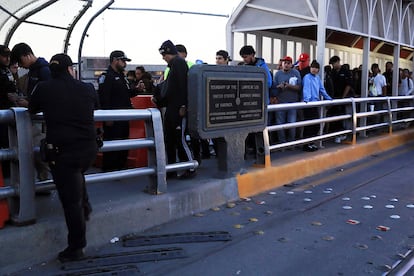The long-term cost of Trump’s mass deportation: The economy could contract between 2.6% and 6%
The example of Arizona, where the departure of 40% of unauthorized migrants led to an annual reduction of 2% of GDP, provides clues as to what may happen at the national level if the Republican candidate delivers on his promise


The possibility of a mass deportation of undocumented immigrants — “the largest in the history of the United States” — has become the spearhead of Donald Trump’s campaign to win the November 5 election. With a discourse that demonizes migrants, the Republican candidate has promised that if he returns to the White House, he will expel anyone who lacks a legal residence permit. The deportation of at least 11 million people who work, study, consume goods and services, pay taxes and are part of their community would not leave the country unscathed.
In addition to the social alarm that the persecution of millions of people would entail, there would also be economic consequences if all those consumers and workers were removed from the economy. Some economists estimate that the economic loss derived from large-scale deportations could range from 2.6% to 6.2% of Gross Domestic Product (GDP, the most widely used measure of national income). At 2023 levels this means losses to the economy of between $711 billion and $1.7 trillion.
“Economic studies have documented that large-scale deportation of unauthorized immigrants would cause the economy to contract. American workers would lose their jobs and their wages would decline. The idea that large-scale deportations would help American citizens is an illusion. Research has documented that it has not worked in the past and will not work in the future,” says Robert Lynch, professor of economics at the University of Washington and author of The Economic Impact on Citizens and Authorized Immigrants of Mass Deportation.
Lynch mentions the effects that other mass deportations have had on the country, those that occurred in the 1930s and 1960s. And more recently, very strict anti-immigrant laws enacted by Arizona in 2007–2008, which led to a large exodus of unauthorized immigrants. According to data from Pew Research, between 2007 and 2016, 40% of undocumented immigrants left that state to return to Mexico or move to another state with less restrictive laws.
A Moody’s Analytics study for The Wall Street Journal found that the departure of immigrants reduced Arizona’s GDP by an average of 2% annually between 2008 and 2015. In addition, total employment in the state between 2008 and 2015 decreased by 2.5%. One of the favorite arguments of those who support deportation is that it takes jobs away from American citizens. However, the Moody’s study shows that native-born Americans and legal immigrants occupied less than 10% of the jobs previously held by unauthorized workers.
“Politicians and deportation advocates claimed the policy would create jobs for American workers, raise wages and grow the economy, but that didn’t happen,” says Lynch.
In 2007, there were nearly half a million undocumented immigrants living in the state, a figure that was reduced to about 275,000 in less than a decade. Between 1990 and 2005, Arizona’s illegal immigrant population had nearly increased fivefold, but beginning in 2004, the state adopted a series of measures to curb illegal immigration and prohibited them from receiving government benefits, including non-emergency hospital care, obtaining driver’s licenses, and being able to access in-state tuition rates.
In 2010, Arizona adopted the controversial SB1070 “Show Your Papers” law, which authorized local police to demand documentation from individuals they suspected of being illegal immigrants, which in practice became a form of harassment of people with darker skin. The law was defeated several times in court and was eventually repealed.
Unwanted jobs
The Arizona case offers an idea of what could happen in the rest of the country, where there are around eight million workers who lack legal papers, representing 5% of the American workforce. In some sectors, their presence is essential: in agriculture they occupy 22% of jobs, in construction they account for 15%, and in manufacturing they are 8% of the workforce, although the figures vary slightly depending on the source due to the difficulty of collecting reliable data from a population that prefers to remain invisible.
“If we were to deport 22% of America’s farmworkers because they are unauthorized immigrants, do you really think American workers would go to the cotton fields of Texas, the sugar fields of Florida, and the peanut farms of Georgia to take low-paying jobs in the scorching heat?” Lynch asks rhetorically.
This economist argues that in addition to the positions that would remain unfilled, the loss of labor would imply a drop in employment for the rest of the population due to the contraction in demand.
“It’s very simple: if you remove 11 million people from the American economy, eight million of whom work and earn hundreds of billions of dollars a year and spend hundreds of billions of dollars each year on food, clothing, housing, health care, entertainment, and thousands of other goods and services, what will happen is that American business sales will fall by billions of dollars. Businesses will cut back on what they produce, they will lay off workers, they will cut wages, and the U.S. economy will contract,” Lynch predicts.
Other experts agree that the job vacancies left by immigrants will lead to an increase in overall unemployment. According to a study by Brookings economist Chloe East, when half a million immigrants are removed from the labor market, about 44,000 jobs of U.S.-born citizens are lost.
“It is clear that unauthorized immigrants accept low-paying, dangerous, and otherwise less attractive jobs more often than U.S.-born and authorized immigrant workers. For example, nearly 6% of unauthorized immigrants work as domestic workers, construction workers or cooks, compared with about 2% of authorized immigrant workers and 1% of U.S.-born workers,” East said.
An aging population and a falling birth rate mean that immigrants will be even more necessary to support the finances of the Social Security system and programs like Medicare. Undocumented immigrants contribute an estimated figure of around $100 billion a year in taxes, while they do not benefit from these public programs. Supporters of deportation argue that they are an unsustainable burden on public finances, using up resources for education and health care, even though statistics show that they contribute more than they receive.
The surge in immigration has also been reflected in increased expulsions. Nationwide, deportations rose from about 200,000 per year in the early 2000s to 400,000 in the late 2000s, and have remained stable at 300,000 annually until the Covid-19 pandemic. Since then, deportations of long-term residents have declined, but other types of expulsions have increased, especially at the border.
President Joe Biden’s measures to control the arrival of undocumented immigrants tightened asylum laws in June, which has had the desired effect of reducing illegal entries. Last month, Border Patrol apprehended 58,038 people at the border, up slightly from July (56,399) but still the second-lowers number of apprehensions since September 2020. Border Patrol apprehensions are on track to be 21% lower than last year.
Looking ahead to the presidential elections in November, immigration policy will be one of the factors that will most influence the vote, along with the economy and reproductive rights.
In Arizona, voters will also decide whether to increase immigration restrictions. The proposal they will vote on would allow local agents to detain individuals who cross the border at places other than immigration checkpoints, with the possibility of jail time and deportation. With the new rule, state judges could also order deportation, something that until now remains the remit of federal judges, and which could be appealed if the law is approved.
Chaos and fear
Domestically, the expulsions Trump is promising would not be easy to carry out. “Trump is talking about large-scale deportations; these are efforts for which there are no resources, and the result would be chaos and a climate of fear,” says Doris Meissner, a partner at the Migration Policy Institute (MPI).
Estimates suggest that deportations would cost between $13,000 and $18,000 per person expelled. Where the money would come from raises another question. According to William Galston, director of the Brookings Government Studies Program, the Insurrection Act could be invoked “and that could give him an opportunity to use parts of the Department of Defense budget to sustain an otherwise unsustainable operation, which would create a really explosive internal situation,” he says. Although it seems like a remote possibility, “in the past, Trump has been willing to create explosive situations to achieve his goals. There is no reason to believe that he would not be willing to do it again. So this is not just a fantasy proposition. This is a real possibility,” he warns.
Sign up for our weekly newsletter to get more English-language news coverage from EL PAÍS USA Edition
Tu suscripción se está usando en otro dispositivo
¿Quieres añadir otro usuario a tu suscripción?
Si continúas leyendo en este dispositivo, no se podrá leer en el otro.
FlechaTu suscripción se está usando en otro dispositivo y solo puedes acceder a EL PAÍS desde un dispositivo a la vez.
Si quieres compartir tu cuenta, cambia tu suscripción a la modalidad Premium, así podrás añadir otro usuario. Cada uno accederá con su propia cuenta de email, lo que os permitirá personalizar vuestra experiencia en EL PAÍS.
¿Tienes una suscripción de empresa? Accede aquí para contratar más cuentas.
En el caso de no saber quién está usando tu cuenta, te recomendamos cambiar tu contraseña aquí.
Si decides continuar compartiendo tu cuenta, este mensaje se mostrará en tu dispositivo y en el de la otra persona que está usando tu cuenta de forma indefinida, afectando a tu experiencia de lectura. Puedes consultar aquí los términos y condiciones de la suscripción digital.
More information
Archived In
Últimas noticias
Maduro pleads not guilty before the federal court in New York: ‘I am still the president of Venezuela’
A new test can detect Alzheimer’s from a finger prick
UN team enters Sudanese city of El Fasher after paramilitary massacre: ‘It’s like a ghost town’
A recipe for resistance: Indigenous peoples politicize their struggles from the kitchen
Most viewed
- Gilles Lipovetsky: ‘If you want to live better and fall in love, take Prozac, don’t look to philosophy’
- Alain Aspect, Nobel laureate in physics: ‘Einstein was so smart that he would have had to recognize quantum entanglement’
- Alvin Hellerstein, a 92-year-old judge appointed by Bill Clinton, to preside over Maduro’s trial in New York
- Why oil has been at the center of Venezuela-US conflicts for decades
- Maduro’s downfall puts China’s relationship with Venezuela to the test










































